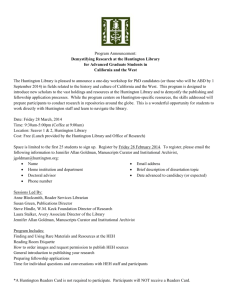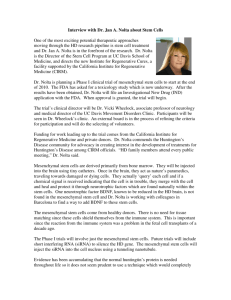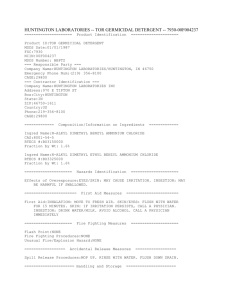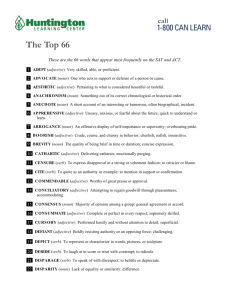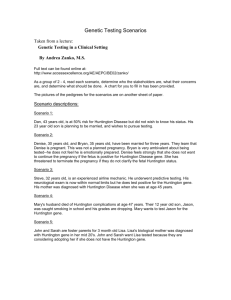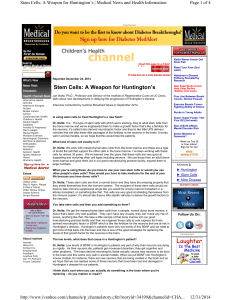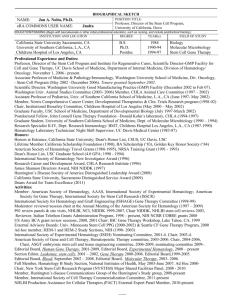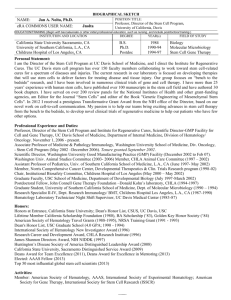The 2009 Huntington Study Group Clinical Research Symposium
advertisement
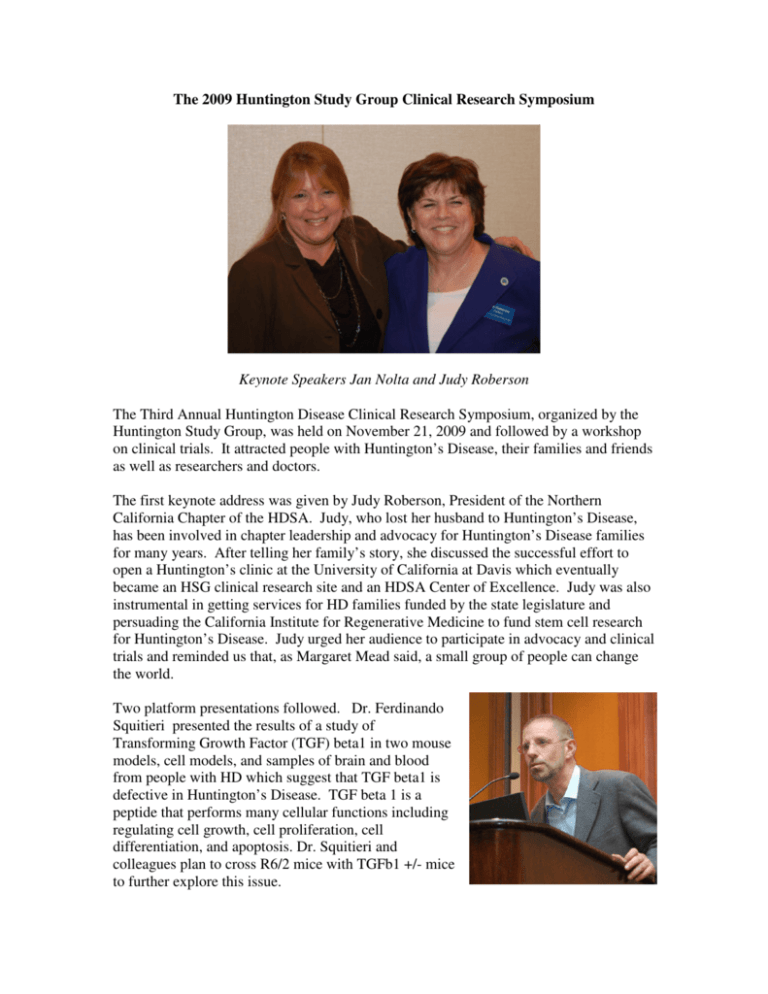
The 2009 Huntington Study Group Clinical Research Symposium Keynote Speakers Jan Nolta and Judy Roberson The Third Annual Huntington Disease Clinical Research Symposium, organized by the Huntington Study Group, was held on November 21, 2009 and followed by a workshop on clinical trials. It attracted people with Huntington’s Disease, their families and friends as well as researchers and doctors. The first keynote address was given by Judy Roberson, President of the Northern California Chapter of the HDSA. Judy, who lost her husband to Huntington’s Disease, has been involved in chapter leadership and advocacy for Huntington’s Disease families for many years. After telling her family’s story, she discussed the successful effort to open a Huntington’s clinic at the University of California at Davis which eventually became an HSG clinical research site and an HDSA Center of Excellence. Judy was also instrumental in getting services for HD families funded by the state legislature and persuading the California Institute for Regenerative Medicine to fund stem cell research for Huntington’s Disease. Judy urged her audience to participate in advocacy and clinical trials and reminded us that, as Margaret Mead said, a small group of people can change the world. Two platform presentations followed. Dr. Ferdinando Squitieri presented the results of a study of Transforming Growth Factor (TGF) beta1 in two mouse models, cell models, and samples of brain and blood from people with HD which suggest that TGF beta1 is defective in Huntington’s Disease. TGF beta 1 is a peptide that performs many cellular functions including regulating cell growth, cell proliferation, cell differentiation, and apoptosis. Dr. Squitieri and colleagues plan to cross R6/2 mice with TGFb1 +/- mice to further explore this issue. Dr. Ashwini Rao presented the results of a study of precision grip control in premanifest HD gene carriers. Precision grip control involves holding an object with the right amount of force (horizontal force) as well as being able to lift or place the object smoothly (vertical force). People with manifest HD use excessive as well as variable force in gripping an object and there is a delay in coordinating horizontal and vertical force. They found that variable force and a delay in coordination of horizontal and vertical force in premanifest gene carriers. However, premanifest carriers use appropriate grip strength. Precision grip control may be a good biomarker for the disease. The second keynote address was given by Dr. Jan Nolta. Dr. Nolta is working toward developing a mesenchymal stem cell therapy which will stop the disease and heal the damage. Mesenchymal stem cells are derived primarily from bone marrow. They will be injected into the brain using tiny catheters. Once in the brain, they act as nature’s paramedics, traveling towards damaged or dying cells. They ‘query’ each cell and if a chemical signal is received indicating that the cell is in trouble, they merge with the cell and heal and protect it through neurotrophic factors which are found naturally within the stem cells. The first step in Dr. Nolta’s research program will be a Phase I study of mesenchymal stem cells injected into the brains of a small number of HD patients. The expected start date will be at the end of the 2010 and Dr. Vickie Wheelock of the University of California at Davis will be the clinical director of the trial. Neurotrophic Factor (BDNF), which is known to be reduced in people with Huntington’s Disease. Dr. Nolta is working with Dr. Elena Cattaneo on this part of the project. Dr. Nolta has been doing research since 1986 which shows that the safety and efficacy of mesenchymal stem cells to deliver protein products to the brain in animal models. Although the treatment should be helpful in healing damaged cells, the HD protein will continue to do its damage so the third step will be to use the mesenchymal stem cells to deliver small interfering RNA. Dr. Karen Anderson reported on a study which compared psychiatric symptoms in early and late onset HD patients. There were no differences among early and late onset patients and the general population in anxiety. Later onset patients had less depression and suicidal ideation than early onset patients. Dr. Douglas Langbehn presented data from PredictHD. As of April 2009, the researchers had accumulated 2179 years of data on 718 participants. They are looking for better clinical predictors of disease onset that can be used in designing preventative clinical trials. They have about 40-50 variable but they wanted to isolate the ones that are strongly and independently predictive and are not subjective to a rater (they found substantial rater variability). Motor impairment cannot be used since that is the measurement of onset. They found four strongly predictive variables: smell identification, Stroop interference test results, speeded tapping rate and paced tapping precision. Smell identification is not independent of CAG variables so the other three are the ones that can be used. In addition, they plan to add brain imaging data to their model. The final keynote presentation was given by Dr. Celia Whitten, Director or the Office of Cellular , Tissue, and Gene Therapies at the FDA. The FDA regulates clinical trials to evaluate the safety and effectiveness of potential treatments. Dr. Whitten explained the many questions that need to be answered and issues that need to be resolved to bring a treatment from the lab to the clinic. There are questions about cells: what cell types are to be used, how many will be needed, their source, whether they are implanted alone or with a scaffold, whether they are modified, and what happens to them over time in vivo. The proposed therapeutic action needs to be specified and appropriate animal data is needed. Issues of delivery, timing, and the number of application must be resolved. The risk/benefit ratio for the intended patient population must be considered. It is important that investigators and sponsors consult with the FDA early in product development to understand what questions need to be answered satisfactorily before clinical trials and can be initiated and then throughout the trial process to understand what data will be needed to support an application for approval. - Text by Marsha L. Miller, Ph.D. - Photographs by Steve Ireland December 21, 2009
